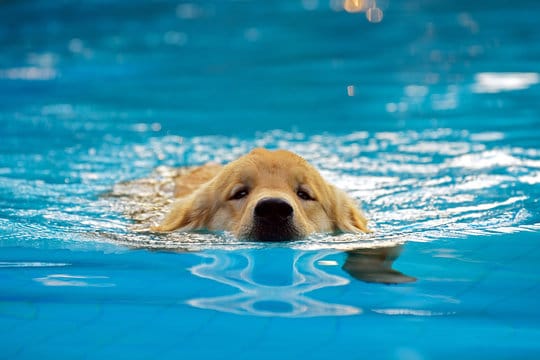There is nothing like a refreshing dip on a hot summer day, and this rings true for Fido as well! Swimming can be a great way for dogs to stay cool and get exercise during hot summer days, but not all breeds are able swimmers or enjoy dipping their paws in water.
Test the Water
Begin by gauging your pup’s natural abilities. Find a shallow body of water for Fido’s first dip and see if he paddles efficiently enough to keep afloat. Despite common perceptions, not all dogs are adept at “doggy paddling.” If your pup is apprehensive about approaching the water, you may want to suit up and join him for his first swim. Never throw a dog in the water or force him to swim. If you force a reluctant dog to swim, you could set him up for a lifetime of water phobia, not to mention, you could degrade the bond of trust between you. Once your dog becomes accustomed to the water, you can it fun by playing fetch with a frisbee or a similar dog-safe floatable toy.
Aquatic Breeds
Certain breeds tend to be more adept swimmers and enjoy the water much more than others. For dog parents of retrievers, for example, you have probably noticed your pooch’s proclivity for water. Golden retrievers, Labs and other hunting breeds generally enjoy swimming. However, do not assume your retriever is a good swimmer as dogs, even of the same breed, have individual likes and abilities. As mentioned above, always introduce your new pup or dog to swimming gradually and assess his ability before allowing him to swim freely.
Non-Aquatic Breeds
Many flat-nosed breeds and smaller breeds tend not to be able swimmers. French bull dogs and pugs, for example, have a hard time swimming, because they must constantly tilt their head up to breathe properly. Corgis and dachshunds also do not make great swimmers due to their short legs and long body shapes. Finally tiny breeds, such as toy pups and chihuahuas, in general need special care when exposed to water. Their tiny size makes them less efficient swimmers and more vulnerable to drowning. Also, many tiny breeds have nervous dispositions and may experience fear or stress while swimming. Once again keep in mind that dogs are individuals, and some small dogs may love the water and be quite efficient little swimmers.
Water Safety
If your dog enjoys swimming, he can swim in a pool or at the beach, but there are special precautions to keep in mind to keep your holiday safe. If you allow your pup to enjoy your garden pool, make sure it has wide ascending steps for him to get in and out of easily. Pools without built-in ascending stairs pose a drowning risk for even large breeds, as there is no way for your dog to get out of the pool on his own. Also keep in mind the chemicals in swimming pools and supervise your dog to make sure he does not swallow too much pool water.
If you plan a beach vacation with your pooch, there are other considerations to keep in mind for a safe swimming experience. Take care of smaller breeds in rough sea- or ocean- waves; it doesn’t take much for a yorkie or chihuahua to become dangerously out of his depth. Saltwater ingestion also poses a danger to dogs if they ingest too much of it, so make sure to bring plenty of fresh water along for your pup to drink. Finally, take care Fido does not eat debris, dead fish, or the sand itself while spending the day by the shore. Ingestion of any of these potential hazards could be dangerous for your dog and require a trip to the vet. Swimming provides a fun and alternative exercise option for your pup on hot summer days when too hot for other forms of exercise. However, treat your canine swimmer like you would your children and make sure he knows how to swim, is comfortable in water, and is always supervised when near water.






